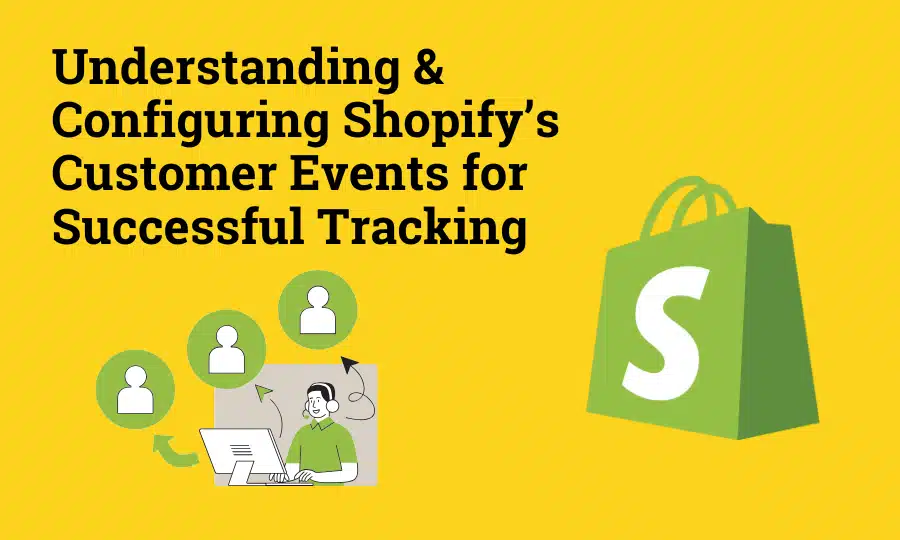Shopify has become one of the leading eCommerce platforms due to its flexibility and seamless integration with marketing tools. However, to scale effectively, merchants need accurate event tracking. This is what powers attribution, retargeting, and optimization across channels such as Google Ads, Meta Ads, TikTok, and email marketing.
In this guide, we’ll break down what Shopify Customer Events are, why they matter, and how to configure them correctly to ensure successful tracking.
What Are Shopify Customer Events?
Customer Events are specific actions users take on your store, such as:
- Page View – When a visitor views a page.
- View Item – When a product page is opened.
- Add to Cart – When a product is added to the shopping cart.
- Initiate Checkout – When a user starts the checkout flow.
- Purchase – When an order is completed.
These events are tracked through Shopify’s native Pixel Manager or custom tracking scripts. They form the backbone of performance marketing because platforms like Meta and Google rely on this event stream to understand user behavior.
Why Customer Events Are Critical for Growth
- Attribution Accuracy
Without correct event tracking, ad platforms under-report conversions, leading to wasted budget and poor optimization. - Audience Building
Events fuel retargeting (e.g., showing ads to users who added products to cart but didn’t purchase). - Campaign Optimization
Platforms use event signals to optimize delivery toward high-quality actions (e.g., optimizing for “Purchase” instead of “Traffic”). - Cross-Channel Consistency
Shopify Customer Events can be synced to multiple tools—ensuring you get unified data across ads, email, and analytics.
Configuring Customer Events in Shopify
1. Use Shopify’s Customer Events Manager
Shopify provides a Customer Events dashboard where you can view and manage tracking. You’ll typically set up:
- Shopify Pixel (native tracking for analytics and basic reporting).
- Custom Pixels (JavaScript snippets for specific platforms or advanced use cases).
- App-based Pixels (installed via integrations like Meta Pixel or Google Ads Tag).
2. Connect Marketing Channels
Most merchants will connect:
- Meta (Facebook) Pixel / Conversions API
- Google Ads Conversion Tracking
- TikTok Pixel
- Klaviyo or Email Platform Tracking
These integrations can be added via Sales Channels or via apps in the Shopify App Store. Ensure each platform receives the right events (purchase, cart, etc.).
3. Verify Event Firing
After setup, test your implementation using:
- Meta Pixel Helper (Chrome extension).
- Google Tag Assistant.
- TikTok Pixel Helper.
- Shopify’s Event Debugger inside the Customer Events section.
Check that all essential events (View Content, Add to Cart, Initiate Checkout, Purchase) fire on the right pages with correct parameters (product ID, value, currency).
Key Takeaways
- Shopify Customer Events form the foundation of your tracking and marketing success.
- Configuring events correctly ensures accurate attribution, better optimization, and stronger remarketing audiences.
- Meta tracking works best with Pixel + Conversions API together, while Google Ads benefits from Enhanced Conversions and verified purchase events.
- Always test your setup with debugging tools before launching campaigns.
With a solid tracking foundation, every dollar you spend on ads works harder—and you’ll be able to scale your Shopify store with confidence.
FAQ’s
How can I track user actions on my Shopify store?
You can use Shopify Customer Events to track actions like page views, adding to the cart, initiating checkout, and completing a purchase.
Why is it important to set up Shopify events correctly?
Correctly configuring events ensures accurate conversion attribution, better campaign optimization, and helps build remarketing audiences.
How do I connect marketing platforms to Shopify to track events?
You can connect platforms like Meta (Facebook), Google Ads, TikTok, and Klaviyo either through direct integration in Shopify or by using apps from the Shopify App Store.
How do I test if Shopify events are firing correctly?
Use testing tools like Meta Pixel Helper, Google Tag Assistant, or TikTok Pixel Helper to check if events are firing on the correct pages.
What is Shopify Pixel and how do I set it up?
Shopify Pixel is a native event tracking tool that can be configured in the Shopify Customer Events Manager for basic analytics and reporting.

